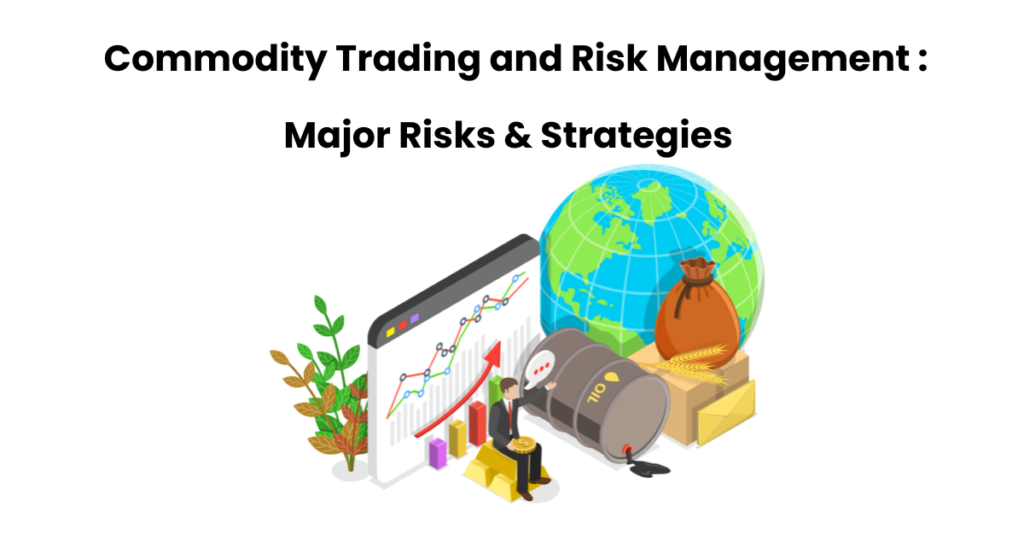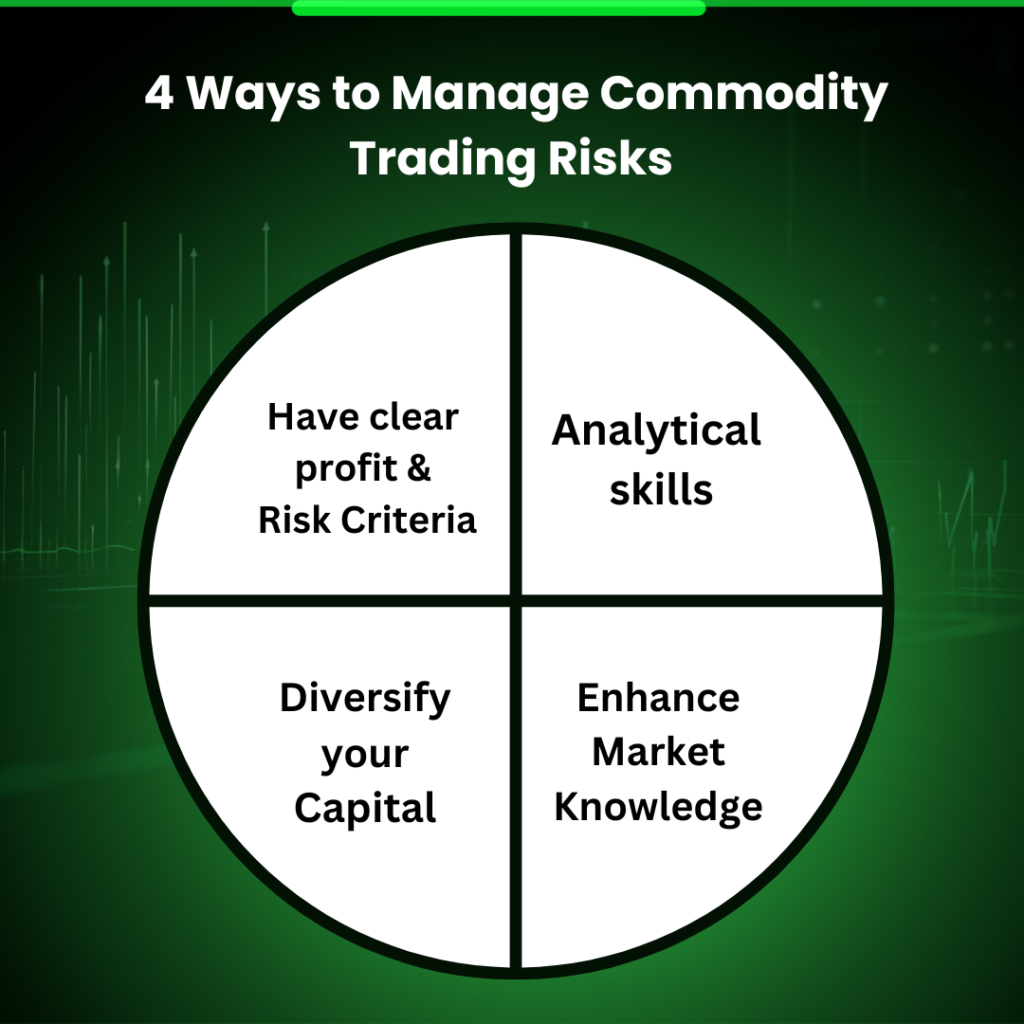Commodity markets offer numerous opportunities to people these days. Traders can invest their money in different commodities and earn a significant amount. However, many people fear entering the commodity trading world due to the potential risks involved. But always remember the phrase, “No risk, no gain.”
You cannot eliminate the risk associated with commodity trading, but you can manage it. So, in Market Investopedia’s blog, we will organize a detailed study of commodity trading and risk management. It will help you master risk and trade commodities like a pro.
Awareness Commodity Trading and Risk Management
Commodity trading is the buying and selling commodities and makes money with the rise and fall of commodity prices. Gold, Silver, Platinum, Copper, Aluminum, Crude Oil, Zinc, Wheat, Rice, and Cattle are the popular commodities to trade.
Confused? Do not worry. Here is a simple example to help you understand. Suppose a person thinks that the price of silver is all set to rise within a few days.
So, the trader opens a buy position when the rate is $32 per troy ounce. Now, after some days, the price has reached $35 per ounce, and the trader has closed the position. In this case, the trader made around $3 per ounce profit.
Here, the silver price moved in traders’ favour. Suppose that if the price drops to $30 in an unexpected market upturn, the trader will incur a loss of $2. That means commodity risk management is essential for traders.
5 Types of Risks in Commodity Trading
Understanding the types of risk is essential for managing commodity risk. Here are the major risks to know before starting your commodity trading journey:

Supply and demand risk:
The demand and supply chain are the most important aspects, especially when learning commodity trading and risk management. The price of a commodity depends highly on supply and demand dynamics.
Higher demand and lower supply result in the rise in commodity prices. Meanwhile, higher supply and lower demand result in a decrease in commodity prices. Unexpected events cause significant changes in these dynamics, ultimately increasing the risk of commodity trading.
A quick glance
Commodity trading is the buying and selling commodities and makes money with the rise and fall of commodity prices.
Gold, Silver, Platinum, Copper, Aluminum, Crude Oil, Zinc, Wheat, Rice, and Cattle are the popular commodities to trade in.
Supply and demand dynamics, low liquidity, political and economic changes, and natural and man-made disasters are risks associated with commodity trading.
Enhance market knowledge, diversify your capital, set clear profit and risk criteria, and boost analytical skills for managing commodity trading risks.
Yes, commodity trading involves the risk of losing money. So, mastering risk management is essential for traders.
Yes, commodity trading is suitable for beginners, but it requires proper knowledge and strategy.
Political and Economic Risk:
A country’s political state and rules and regulations also have a huge impact on commodity import and export. Unpredictable events like government change, diplomatic meetings, speeches, and announcements increase commodity trading risks.
In addition, changes in tax guidelines, trade agreements, tariffs and other regulations further enhance the risk. Also, changes in interest rates, employment reports, CPI, PMI, import-export balance and others may directly affect your trade.

Market Liquidity Risk:
Participants in the markets over a period also impact your trade. Liquidity deals with a degree of ease in buying and selling a commodity, and it is only high when there is more participation.
Have you ever wondered why gold trading is so popular? Because it is a highly liquid asset. Numerous commodities are present in the market, but not all are highly liquid. Trading commodities with less market liquidity delay trade entries and exits that increase market risk.
Market correlation risk:
The commodity market has positive and negative correlations with other financial assets or markets. It includes stocks of related companies, forex currencies, and many others.
The most famous commodity correlation is between USD and Gold. It has been seen that whenever USD falls, gold rises, and vice versa. So, events like a currency revaluation, devaluation, or stock market crash increase the challenges for commodity traders.
Natural and Man-Made Disaster:
Commodity production is highly affected by season, weather, and other natural factor. Natural disasters like drought, storms, floods, hurricanes, earthquakes and others have a huge impact on commodity production.
In addition, man-made disasters like wars, nuclear blasts, terrorism, cyber-attacks, commodity industry strikes, and others also disrupt the commodity market. These events cause obstacles in commodity traders’s journey.
Strategies to Manage Commodity Risk
Now that you have understood the relationship between commodity trading and risk management. It is time to know some of the strategies that help you to master commodity trading risk:
Enhance Market Knowledge:
Knowledge is the foremost weapon for dealing with commodity risk. You have already learned about different risks. Now, organize a detailed study of the commodity market and how it works.
Keep yourself updated on different factors affecting commodity prices and what impact they have made. In addition, stay informed of financial news, market trends, and economic events.
Diversify your Capital:
Risk is a part of trading, whether dealing in commodities or other assets. So you cannot escape from the market risk, but you can diversify it.
Do not spend all your capital on one commodity; try to diversify it into commodities with different market conditions. Further, you can even consider trading forex currencies, cryptocurrencies, stocks, or indices to spread your capital. In such a way, you can earn profit from other trades when your commodity trades run at a loss.
Have clear profit and risk criteria:
The amount of risk arises when you keep unrealistic expectations from trade. So, always set your profit expectations by considering the capital, type of commodity, time frame, strategy, and risk-taking capacity. In addition, always trade following proper risk to reward ratio and leverage and never avoid placing stop-loss orders.
Analytical skills:
The market conditions are similar for traders; even after that, some traders make money while some lose. That is because of analytical skills; trading is all about making the right predictions. And you can only make the right prediction when you are pro in analyzing market conditions.
Dealing with market risk has become quite easy when you are aware of what’s going on in the market. So keep your watch on the market and organize fundamental, sentimental, and technical analysis.
Wrapping Up
Commodity trading can give you profitable outcomes, but only when you know risk management. Traders generally aim to earn maximum profit. However, the right objective should be to earn a decent profit by managing market risk and losses. You now understand the basics of commodity trading and risk management strategies. For detailed information, you can even visit our commodity trading education section to get well-versed in the market.
